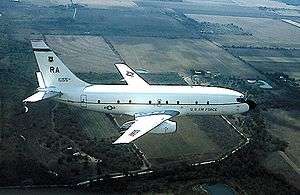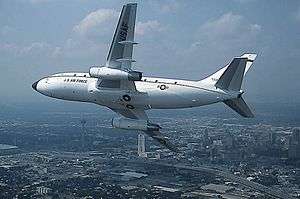Boeing T-43
The Boeing T-43 was a modified Boeing 737-200 used by the United States Air Force for training navigators, now known as USAF combat systems officers. Informally referred to as the Gator (an abbreviation of "navigator") and "Flying Classroom", nineteen of these aircraft were delivered to the Air Training Command at Mather AFB, California during 1973 and 1974. Two additional aircraft were delivered to the Colorado Air National Guard at Buckley ANGB (later Buckley AFB) and Peterson AFB, Colorado, in direct support of cadet air navigation training at the nearby U.S. Air Force Academy. Two T-43s were later converted to CT-43As in the early 1990s and transferred to Air Mobility Command and United States Air Forces in Europe, respectively, as executive transports. A third aircraft was also transferred to Air Force Materiel Command for use as the 'Rat 55' radar test bed aircraft and was redesignated as an NT-43A. The T-43 was retired by the Air Education and Training Command in 2010 after 37 years of service.[3]
| T-43/CT-43 | |
|---|---|
 | |
| Role | Military training and transport aircraft |
| Manufacturer | Boeing |
| First flight | 10 March 1973[1] |
| Introduction | September 1973[2] |
| Retired | September 2010 |
| Status | Retired |
| Primary user | United States Air Force |
| Number built | 19 (one written off) |
| Unit cost |
$5,390,000[2] |
| Developed from | Boeing 737 |

Design and development
On 27 May 1971, the United States Air Force (USAF) placed an order for 19 T-43s, modified versions of the Boeing 737-200 as a replacement for the USAF's aging fleet of Convair T-29 navigation trainers, as part of the Undergraduate Navigator Training System. The Boeing aircraft was selected in preference to a trainer based on the Douglas DC-9.[4]
From its entry into service in 1974 until the mid-1990s, the T-43As were used for all USAF Undergraduate Navigator Training. Starting in the mid-1990s, the T-43As were used for USAF Undergraduate Navigator/Combat Systems Officer training with the exception of those USAF Navigators/CSOs slated for the F-15E and B-1B).
In 1976, with the U.S. Navy's retirement of its T-29 aircraft and deactivation of its associated Training Squadron TWENTY-NINE (VT-29) at NAS Corpus Christi, Texas, those Student Naval Flight Officers destined for land-based naval aircraft began training in USAF T-43s at Mather AFB under a program known by USAF as Interservice Undergraduate Navigator Training (IUNT)[5][6] and by the U.S. Navy as the NAV pipeline for training Student Naval Flight Officers slated for eventual assignment to land-based naval aircraft.
Externally, the T-43 differs from the civilian aircraft by having more antennas and fewer windows.
The T-43A had stations on board for twelve navigator students, six navigator instructors, as well as a pilot and co-pilot. The student training compartment was equipped with avionics gear as used in contemporary operational aircraft. This included search and weather radar; VHF omnidirectional range (VOR) and Tactical air navigation system (TACAN) avionics systems; Long Range Navigation System (LORAN-C); inertial navigation system; radar altimeter; and all required VHF, UHF and HF communications equipment. Five periscopic sextant stations spaced along the length of the training compartment were used for celestial navigation training. However, with the advent of GPS, student navigators were no longer taught celestial navigation or LORAN.
The aircraft had considerably more training capability than the aircraft it replaced, the T-29. Introduction of the T-43 into Air Force Undergraduate Navigator Training (UNT) in 1974 also enabled the United States Navy to disestablish Training Squadron TWENTY-NINE (VT-29) and its T-29 aircraft at Naval Air Station Corpus Christi, Texas in 1975. VT-29 had been training student Naval Flight Officers for various land-based naval aircraft such as the P-3 Orion, EP-3 Aries, and variants of the Lockheed C-130 Hercules. The Navy then merged its Student NFO (SNFO) "NAV" pipeline with the Air Force's UNT program in 1976, forming Interservice Undergraduate Navigator Training (IUNT) with both Navy students and USN and USAF instructors.
Inside each T-43A training compartment were two minimum proficiency, two maximum proficiency and 12 student navigator stations. Two stations form a console, and instructors could move their seats to the consoles and sit beside students for individual instruction. The large cabin allowed easy access to seating and storage, yet reduces the distance between student stations and instructor positions.
The aircraft were initially assigned to the 323rd Flying Training Wing (323 FTW) of the Air Training Command (ATC) at Mather AFB, California, plus two additional aircraft assigned to the Colorado Air National Guard at Peterson AFB, Colorado to support introductory air navigation training for cadets at the United States Air Force Academy. When the 323 FTW was inactivated and Mather AFB closed by Base Realignment and Closure (BRAC) action in 1993, most of the T-43s were transferred to the 12th Flying Training Wing (12 FTW) of the Air Education and Training Command (AETC) at Randolph AFB, Texas, with the 12 FTW assuming the specialized undergraduate navigator training (SUNT) role while the U.S. Navy's Training Air Wing SIX (TRAWING 6), a Naval Air Training Command organization at NAS Pensacola, Florida, assumed a role for training those USAF student navigators slated for eventual assignment to the F-111, EF-111, F-15E and B-1B.
Operational history



The T-43 was last[7] based at Randolph Air Force Base, Texas and operated originally by the 558th Flying Training Squadron (558 FTS) and since 1996 by the 562d Flying Training Squadron and by the 563d Flying Training Squadron since 1999. The two additional aircraft used for introductory air navigation training of USAF Academy cadets continue to be operated by the Colorado Air National Guard at Buckley AFB and Peterson AFB, Colorado.
In addition, several T-43A were later modified to a transport aircraft configuration designated CT-43A, such as one previously operated by the 6th Air Mobility Wing (6 AMW) at MacDill AFB, Florida in support of United States Southern Command (USSOUTHCOM) for transport of the USSOUTHCOM Commander in Central and South America. The 6 AMW's CT-43A aircraft was replaced by a Gulfstream C-37A aircraft in early 2001.
Throughout its service in the Air Training Command and the successor Air Education and Training Command, no T-43 was ever lost in a mishap. Among the T-43s removed from navigator training and converted to CT-43A executive transports, one aircraft assigned to the 86th Airlift Wing (86 AW) at Ramstein Air Base, Germany to support United States European Command (USEUCOM) crashed in Croatia in 1996 while carrying then-U.S. Secretary of Commerce Ron Brown and 34 other passengers. There were no survivors and subsequent investigation determined that this was a controlled flight into terrain (CFIT) mishap as a result of pilot error.
On 17 September 2010, the last T-43 flight was flown at Randolph Air Force Base, and it was subsequently retired from the active Air Force service after 37 years of service.
Variants
- T-43A
- Model 737-253 powered by two JT8D-9 engines and provision for 3 instructors and 16 student navigators, 19 built.[8]
- CT-43A
- T-43As converted as staff or command transports. Six T-43A were converted.
- NT-43A
- One T-43A converted as a radar test bed aircraft.
Aircraft on display
- 73-1153 City of San Antonio – T-43A on static display at Randolph Air Force Base in Universal City, Texas.[9][10]
Specifications (T-43A)
Data from Encyclopedia of World Military Aircraft[11]
General characteristics
- Crew: 2
- Capacity: 19
- Length: 100 ft (30 m)
- Wingspan: 93 ft (28 m)
- Height: 37 ft (11 m)
- Wing area: 980 sq ft (91 m2)
- Airfoil: root: BAC 449/450/451 ; tip: BAC 442[12]
- Empty weight: 60,210 lb (27,311 kg)
- Max takeoff weight: 115,000 lb (52,163 kg)
- Fuel capacity: 5,950 US gal (4,960 imp gal; 22,530 L)[13]
- Powerplant: 2 × Pratt & Whitney JT8D-9A turbofan engines, 14,500 lbf (64.4 kN) thrust each
Performance
- Maximum speed: 509 kn (586 mph, 943 km/h) at 23,500 ft (7,163 m)
- Cruise speed: 500 kn (580 mph, 930 km/h)
- Never exceed speed: 545 kn (627 mph, 1,009 km/h)
- Range: 2,600 nmi (3,000 mi, 4,800 km)
- Endurance: 6 hours
- Rate of climb: 3,760 ft/min (19.1 m/s)
See also
- USAF CT-43 crash during an NDB approach that killed U.S. Secretary of Commerce Ron Brown
Related development
Aircraft of comparable role, configuration and era
Related lists
References
- Notes
- Bowers 1989, p. 499.
- Federation of American Scientists Military Analysis Network T-43 page retrieved 2008-01-17.
- Michelle Tan. "Air Force bids farewell to T-43". Army Times Publishing Company.
- Air Enthusiast September 1973, p. 111.
- "DaddyBobPhotos.com - Aircraft". daddybobphotos.com. Retrieved 6 April 2018.
- "Historic California Posts, Mather Air Force Base". californiamilitaryhistory.org. The California State Military Museum. Archived from the original on 26 March 2017. Retrieved 11 September 2018.
- "Factsheets: T-43A". Archived from the original on September 3, 2009.
- Andrade, John (1979). U.S.Military Aircraft Designations and Serials since 1909. Midland Counties Publications. p. 169. ISBN 0-904597-22-9.
- "Retired T-43 put on display". Air Education and Training Command. 10 November 2010. Retrieved 6 October 2017.
- "Airframe Dossier - Boeing T-43A, s/n 73-1153 USAF, c/n 20700". Aerial Visuals. AerialVisuals.ca. Retrieved 6 October 2017.
- Donald and Lake 1996, p. 80.
- Lednicer, David. "The Incomplete Guide to Airfoil Usage". m-selig.ae.illinois.edu. Retrieved 16 April 2019.
- Air Enthusiast September 1973, p. 113.
- Bibliography
- "Boeing's Military Twin: The Model 737 dons USAF uniform as a navigation trainer". Air Enthusiast. Vol. 5 no. 3. September 1973. pp. 111–115.
- Bowers, Peter M. (1989). Boeing Aircraft since 1916. London: Putnam. ISBN 0-85177-804-6.
- Donald, David; Lake, Jon (1996). Encyclopedia of World Military Aircraft. London: Aerospace Publishing. ISBN 1-874023-95-6.
External links
| Wikimedia Commons has media related to Boeing T-43. |
- http://www.militaryaircraft.de/pictures/military/aircraft/T-43/T-43A_Gator.html
- https://web.archive.org/web/20090127042205/http://gruntsmilitary.com/t43a.shtml
- http://www.globalsecurity.org/military/agency/usaf/12ftw.htm
- https://www.youtube.com/watch?v=TGU5wluWWms YouTube video of the closing ceremony